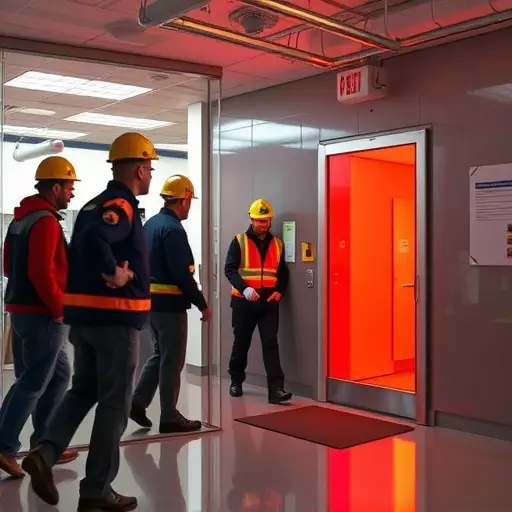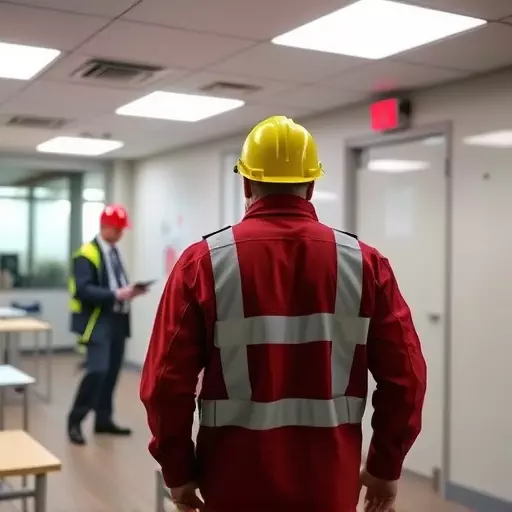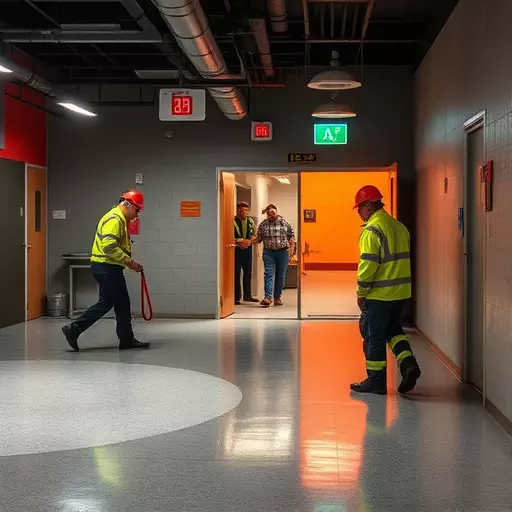Developing a robust Emergency Action Plan (EAP) is vital for workplace safety, providing structured response strategies for various emergencies. This includes clear instructions tailored to facility layout, communication protocols, and step-by-step procedures for evacuation, rescue, and recovery. Regular fire safety training and workplace evacuation drills are essential to ensure staff proficiency in using extinguishers, evacuating via designated routes, and assembling at pre-determined points. Continuous plan reviews and updates maintain relevance with evolving workplace safety standards. Identifying potential hazards like fires, chemical leaks, natural disasters, or equipment malfunctions is crucial for implementing tailored risk mitigation strategies. Regular emergency training cultivates staff awareness and readiness, fostering a culture of preparedness that enhances overall workplace safety.
In today’s world, preparedness is key to ensuring workplace safety. Developing a robust Emergency Action Plan (EAP) is an essential step towards mitigating risks and saving lives. This comprehensive guide delves into the critical components of EAP development, from identifying potential hazards and risks to designing effective evacuation drills and fire safety training. By implementing these strategies, organizations can enhance their emergency response capabilities, fostering a culture of preparedness that prioritizes both employee well-being and workplace efficiency.
- Understanding Emergency Action Plan Development: A Comprehensive Guide
- Identifying Potential Hazards and Risks in the Workplace
- Designing Effective Evacuation Drills and Fire Safety Training
- Implementing and Regularly Updating Your Emergency Response Strategy
Understanding Emergency Action Plan Development: A Comprehensive Guide

Developing an Emergency Action Plan (EAP) is a critical component of ensuring workplace safety and preparedness. It serves as a structured guide for employees to respond effectively during emergencies, whether it’s a fire, natural disaster, or other critical incidents. This comprehensive process involves identifying potential hazards, establishing clear communication protocols, and creating step-by-step procedures for evacuation, rescue, and recovery.
A well-crafted EAP includes detailed instructions tailored to your facility’s unique layout and operational needs. It emphasizes the importance of regular workplace evacuation drills to familiarize staff with their roles and responsibilities. Integrating fire safety training within these drills ensures that employees know how to use fire extinguishers, evacuate through designated routes, and assemble in pre-determined meeting points. Regular reviews and updates are essential to keep the plan current and effective, aligning with evolving workplace safety standards and best practices.
Identifying Potential Hazards and Risks in the Workplace

Identifying potential hazards and risks in the workplace is a critical step in developing an effective emergency action plan. This process involves a thorough assessment of the work environment to pinpoint any dangers that could pose a threat to employees’ safety. Such hazards may include fire risks, chemical leaks, natural disasters, or even internal incidents like equipment malfunctions. By recognizing these potential threats, organizations can implement tailored strategies to mitigate risks and ensure workplace safety.
Regular emergency workplace safety training and fire safety training sessions play a pivotal role in this regard. These training programs equip employees with the knowledge and skills needed to respond appropriately during an emergency. Workplace evacuation drills, for instance, help foster an understanding of safe evacuation routes, assembly points, and overall crisis management. Such proactive measures not only enhance individual preparedness but also contribute to a well-coordinated response when facing unforeseen challenges.
Designing Effective Evacuation Drills and Fire Safety Training

Effective emergency preparedness in the workplace starts with well-designed evacuation drills and fire safety training. These exercises are crucial components of an overall emergency action plan, ensuring that employees know exactly what to do in case of a fire or other emergency. Regularly scheduled drills should simulate real-life scenarios, covering various types of emergencies, such as fire, natural disasters, or medical emergencies. This helps to create a culture of awareness and preparedness among staff.
During training sessions, it’s essential to educate employees on evacuation routes, assembly points, and the proper use of fire equipment like extinguishers. Hands-on practice in these areas enhances understanding and speeds up response times during an actual emergency. Additionally, providing clear instructions and consistent messaging ensures that everyone is aligned with the plan, fostering a safe and efficient workplace environment.
Implementing and Regularly Updating Your Emergency Response Strategy

Implementing and regularly updating your emergency response strategy is paramount for maintaining optimal workplace safety. It involves a multifaceted approach, encompassing routine workplace evacuation drills, comprehensive fire safety training, and the integration of new protocols as they emerge. Regular exercises and simulations allow employees to familiarize themselves with procedures, fostering a culture of preparedness. This proactive stance not only minimizes potential risks but also enhances overall emergency workplace safety.
A dynamic strategy ensures that your team is equipped to handle evolving threats effectively. It includes staying abreast of industry standards, regulatory changes, and best practices related to emergency response. Leveraging resources from professional organizations and safety training institutions can significantly contribute to updating your plan. Regular reviews and updates are essential to guarantee a robust strategy that remains relevant and effective in the face of changing circumstances.


